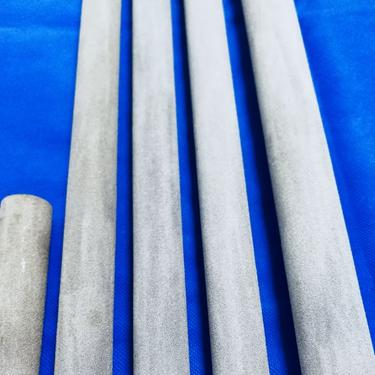High-flux tube and high-flux tube heat exchanger
What is high-flux tube?
High-flux tube is a new product that organically combines sintering method and machining technology, which refers to a type of heat exchanger tube that is specifically designed to handle high heat transfer rates. This product can simultaneously increase the heat transfer coefficient of the inside and outside of the heat exchange tube, so it can greatly increase the heat exchange coefficient of the entire heat exchange tube, that is, the total heat exchange effectiveness. In order to solve the current bottleneck problem that only improves the one-sided enhanced heat transfer coefficient and the total heat transfer efficiency is low in the process of enhanced heat transfer, the heat transfer efficiency of the heat exchange tube and the heat exchanger is greatly improved.
On the one hand, the high-flux tube can reduce the steam demand, on the other hand, it can improve the heat transfer capacity. In large heat exchange systems, because of the need for small temperature differences, the number of reboilers is very large. At this time, the use of high-flux tubes can reduce the number of reboilers by 3/4, and the temperature difference ΔT is only 5 ° C. The use of high-flux tubes to replace traditional smooth tubes can eliminate heat transfer bottlenecks, meet the needs of greater heat transfer loads, and significantly increase production. At the same time, while maintaining design efficiency, lower steam pressure can be used to reduce cost consumption.
The term "high-flux" indicates that these tubes are capable of accommodating high heat fluxes, which refers to the amount of heat transferred per unit area. High-flux tubes are designed with features that enhance heat transfer, such as extended surfaces, fins, or internal enhancements like turbulators. These features increase the surface area available for heat transfer and promote better fluid mixing, resulting in improved heat transfer performance.
The main high-flux tube type:
Outer surface sintered porous layer / inner surface low fin, outer surface longitudinal groove / inner surface sintered porous layer, outer surface serrated surface / inner surface sintered porous layer, outer surface fin / inner surface sintered porous layer.
High-flux tube material and size:
Material: carbon steel, white copper, stainless steel, copper and brass, etc.
Size: outer diameter 15 ~ 40mm, length 500 ~ 12000mm
In general, the high-flux tube has a reinforced section in the middle and smooth sections at both ends, which is convenient for pipe penetration and expansion. High-throughput tubes can be customized according to user requirements. Products are packed in wooden boxes.
What is high-flux tube heat exchanger?
A high-flux tube heat exchanger is a heat exchanger that utilizes high-flux tubes for efficient heat transfer. It consists of a series of these tubes, usually arranged in a parallel or counterflow configuration, with one fluid flowing inside the tubes and the other fluid flowing outside the tubes. The high-flux tubes facilitate the transfer of heat from one fluid to the other.
High-flux tube heat exchangers are commonly used in various industries, including power generation, chemical processing, oil and gas, and refrigeration. They are particularly beneficial in applications where there is a need for compact and efficient heat transfer, as they can provide high thermal performance in a relatively small footprint.
Applicable medium for high flux tube heat exchanger
Ethylene glycol (MEG), diethylene glycol (DEG, diethylene glycol), trichloroethylene, ethane, propylene and ethanol.
Applications of high-flux tube heat exchangers
High-flux tubes and high-flux heat exchangers can be used in various heat exchange equipment with phase changes, namely evaporators, evaporators, reboilers, and condensers, specifically, such as ethylene vaporizers, ethylene separation device towers The main condenser-evaporator of the top condenser and reboiler, ethylene glycol evaporation, aromatics unit, and air separation unit. And natural gas liquefaction, low temperature refrigeration, air separation, seawater desalination, etc.
(1) Refinery and petrochemical plant
Such as the top condenser and reboiler of ethylene separation device, ethylene vaporizer, catalytic oil slurry evaporator, ethanol evaporator, ethylene glycol evaporator, etc., can reduce the heat exchanger area by more than 80%, and can reduce the horsepower of the refrigerator . The porous surface with enhanced boiling heat transfer has stable performance during long-term operation, and no coking or scaling occurs. At the same time, the consumption of the heat source medium can be greatly reduced, and even the temperature of the heat source medium can be reduced.
(2) Natural gas purification and separation device
For example, in the reboiler condenser of a low-temperature air separation plant, on the one hand, the initial cost of the evaporative-condensing (cooling) heat exchanger (reduced area) can be reduced; on the other hand, the power consumption is reduced due to working under low temperature differences.
(3) Seawater desalination and waste heat utilization.
Benefit analysis of high-flux tube heat exchanger
To build a million-ton large-scale ethylene complete equipment, the total investment is generally more than 20 billion yuan. According to historical experience data, the cost of heat exchange equipment accounts for about 30% of the total investment, then the cost of heat exchange equipment for each large ethylene project will be Reached around 7 billion yuan. However, since Chinas energy utilization efficiency is only 34%, which is equivalent to the level developed 20 years ago, it is ten percentage points lower than developed. The development of a high-efficiency heat exchanger that can transfer more heat with as little temperature difference as possible and as little heat transfer area as possible can be said to be directly related to the first step of industrial energy-saving development. The use of high-flux tube heat exchange tubes and their high-efficiency heat exchangers is the most effective and the most economical means of improving energy efficiency.
Overall, high-flux tubes and high-flux tube heat exchangers are specialized components designed to handle high heat transfer rates and are used in applications that require efficient heat exchange between fluids.


